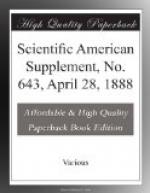The materials of concrete as used at present are cement, sand, gravel, broken stone, and, of course, water. It is, perhaps, unnecessary to say that one of the primary requirements in materials is that they should be clean. Stone should be angular, gravel well washed, sand coarse and sharp, cement fine and possessing a fair proportion of the requirements laid down in the orthodox specification. The addition of lime water, saccharated or otherwise, has been suggested as an improvement over water pure and simple, but no satisfactory experiments are on record justifying the addition of lime water.
Regarding the mixing of cement and lime with saccharated water, the writer made some experiments several months ago by mixing neat cement and lime with pure water and with saccharated water, with the result that the sugar proved positively detrimental to the cement, while it increased the tenacity of briquettes of lime.
Stone which will pass a 2 inch is usually specified for ordinary concrete. It will be found that stone broken to this limit of size has fifty per cent. of its bulk voids. This space must be filled by mortar or preferably by gravel and mortar. If the mixing of concrete is perfect, the proportion of stone, by bulk, to other materials should be two to one. A percentage excess of other materials is, however, usually allowed to compensate for imperfection in mixing. While an excess of good mortar is not detrimental to concrete (as it will harden in course of time to equal the stone), still on the score of economy it is advisable to use gravel or a finer grade of stone in addition to the 2 inch ring stone to fill the interstices—gravel is cheaper than cement. The statement that excess in stone will give body to concrete is a fallacy hardly worth contradicting. In short, the proportion of material should be so graded that each particle of sand should have its jacket of cement, necessitating the cement being finer than the sand (this forms the mortar); then each pebble and stone should have its jacket of mortar. The smaller the interstices between the gravel and stones, the better. The quantity of water necessary to make good concrete is a sorely debated question. The quantity necessary depends on various considerations, and will probably be different for what appears to be the same proportion of materials. It is a well known fact that brick mortar is made very soft, and bricks are often wet before being laid, while a very hard stone is usually set with very stiff mortar. So in concrete the amount of water necessarily depends, to a great extent, on the porosity or dryness of the stone and other material used. But as to using a larger or smaller quantity of water with given materials, as a matter of observation it will be found that the water should only be limited by its effect in washing away mortar from the stone. Where can better concrete be found than that which has set under water? A certain definite amount




